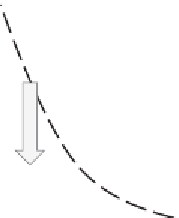Geoscience Reference
In-Depth Information
mean temperature
profile
mean wind
speed profile
cool
warm
slow
fast
τ
H
Figure 3.5
Sketch of turbulent transport and its relation to the surface lux and the
mean proile of the transported quantity: heat entering the layers close to the ground is
removed by turbulent motion of air (left) and surface friction (denoted by
τ
) removes
momentum from the air which is replenished by downward motion of fast air (right).
3.3.2 Intermezzo: Conserved Quantities, Scalars and Vectors
We have seen earlier that turbulent vertical transport involves the vertical motion of
air. In the atmosphere, pressure and density decrease with height. This implies that
if a parcel of air moves upward it will experience a small decrease in pressure, and
consequently it will expand. In the case of an adiabatic process, this expansion will
take place at the expense of the internal energy of the parcel; hence its temperature
will decrease. But this loss of internal energy can be regained if the parcel is brought
back to its original pressure. To eliminate these reversible changes from the analysis,
we will use the potential temperature (see
Appendix B
) from here on.
4
This is one
example of a variable that is conserved for adiabatic processes.
Likewise, many indicators for the amount of water vapour (or another gas) change
when the pressure (and density) of an air parcel changes (see
Appendix B
). Only spe-
ciic humidity
q
(as well as the mixing ratio) is conserved for adiabatic processes, as
q
is the ratio of vapour density and air density. Both densities change at the same rate
under adiabatic lifting, and hence
q
does not change.
More generally, a consequence of the change in volume of parcels that move
upward or downward is that the description of the contents of that parcel (heat, mois-
ture, momentum) per unit volume is not very useful. Therefore, when vertical motion
is involved, we always use speciic quantities (i.e., content per unit mass):
•
Speciic enthalpy:
c
p
θ
(in J kg
-1
)
•
Speciic humidity:
q
(in kg kg
-1
)
Speciic momentum:
•
u
(momentum is mass times velocity, hence speciic momentum is
just velocity: in m s
-1
).
4
For the speciication of changes in enthalpy due to diabatic (i.e., non-adiabatic) processes the potential temperature
can equally well be used as the normal temperature because
changes
in temperature and potential temperature are
identical.















Search WWH ::

Custom Search